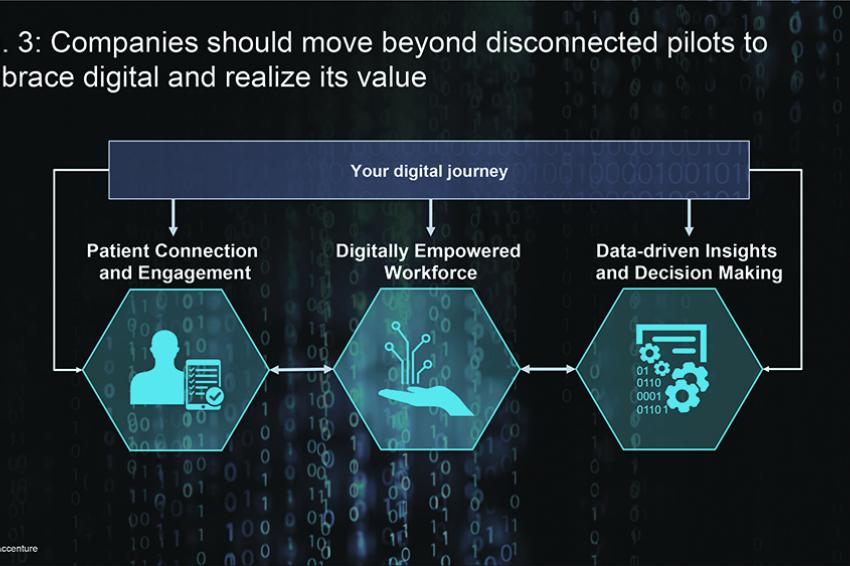Digital’s Transformative Power across R&D
Keeping Pace with Stakeholder Expectations in the Pharmaceutical Industry
The pharmaceutical industry is making a fundamental shift from a product- to a patient-outcome focused approach. Consequently, R&D organizations must also reflect this strategic shift – from the processes used to the capabilities in which they invest.
The healthcare industry continues to experience massive changes driven by both external and internal factors, which combined present the opportunity for a deeper reflection and a radical business model transformation. External demographic and economic pressures include an aging global population, the rise of chronic diseases, changing customer expectations, increased patient involvement and amplified regulatory scrutiny. Companies are challenged by the need to understand, prioritize and leverage the growing opportunities made available by technology proliferation and capabilities. Therefore, it is essential for R&D organizations to embrace digitalization in a more holistic way or risk being outdone by their competition.
The industry has to shift from volume-based models to a value-based approach, which means that companies must focus on delivering outcome-based health and therapy management services. R&D organizations have an opportunity to support this by leveraging the power of digital technologies. Truly digital business models are information intensive, technology-enabled and disruptive, while focusing on creating and delivering an exceptional customer experience and amplifying internal performance.
R&D’s primary stakeholders – patients, providers, payers, regulators and employees – are accustomed to living in a digital world where instant access to information and improved interactions are standard. They expect the same experiences during their interactions with pharmaceutical and biotechnology companies.
However, many R&D organizations lag their stakeholders’ expectations in adopting digital. None of the typical reasons for delay – hesitancy to adopt new technologies, risk adverse cultures and the uncertainty of regulations and perception of health authorities – should prevent R&D organizations from embracing digital.
What Value Can Digital Help to Drive in R&D?
Digital capabilities can be applied across three major industry imperatives that are enablers to R&D's future success:
First, applications of digital solutions and services help to generate and document a holistic, shareable picture of patient health that finally enables a better understanding of the patient’s disease. Using real-world evidence to study existing therapies and the corresponding impacts on patient lives, understanding, incorporating, and testing digital solutions and services during the drug development process, and assisting clinicians with collecting the appropriate data, finally result in the desired efficaciousness and effectiveness of products. Companies can deliver an improved patient experience, while integrating perspectives from caregivers and advocates to provide more seamless and holistic care.
Secondly, a digitally empowered workforce generates the opportunity to operate differently, with improved productivity both within and across functions of an R&D organization. However, effective implementation of a digitally-empowered business model requires a shift from the traditional analog mindset to an innovative and strategic approach to operations and decision making across the R&D value chain (e.g., early development, clinical, data management, regulatory, PV, medical). These equally include digital solutions and services within the workforce like virtual reality or gamification techniques across clinical groups. But it also requires a greater understanding of organizational needs and expectations of each employee and an embedded digital savviness in the organization to facilitate collaboration, innovation, agility and flexibility within the R&D functions.
Finally, digital capabilities enable companies to aggregate and synthesize historical data, internal data (e.g., clinical trial data, operational data, genomics data) and external data (e.g., electronic medical records, claims data) that empower R&D organizations to generate insights and drive scientific and operational excellence. This not only allows to make decisions in the R&D processes earlier, but it also means a shift to an informed and predictive approach – one that combines benchmarking and statistical models to determine acceptable relevant performance deviations based upon pre-defined outcomes, as well as actions that create value for the organization.
With the appropriate capabilities and understanding of current data, companies can deploy analytics to improve both the scientific understanding of their products, and the effectiveness of their operations across R&D functions. Realizing the true value of internal and external data, in combination with analytics tools is one of the largest benefits of embracing digital for R&D. However, to work towards success, R&D organizations must interact with patients and stakeholders differently and change internal operations to generate, collect and consume the data and unlock the insights that a digital approach can uncover.
Digital Is already Transforming R&D
Early digital adopters are leveraging pilots in clinical trials and/or submitting new products for regulatory approval with a digital companion. However, there is opportunity to move beyond disconnected pilots and isolated initiatives to embrace digital, and realize the value it offers. Digital can sharpen the focus on patients and improve outcomes, provided there is a clear understanding of the impact digital has had in transforming other sectors.
In order to increase the impact of digital capabilities aligned to the industry imperatives, organizations should look to identify a holistic set of cross-functional services and solutions which can be applied to all activities within the value chain, from scientific collaboration internally and externally, to the transition from in vitro to in vivo, to phase I through phase III clinical trials and initial product submissions, to ongoing safety monitoring, product maintenance, and key opinion leader (KOL) and health authority interactions through various channels and partnership methods.
In order to assess the organization’s readiness toward adoption of digital capabilities, we must look to the functional and technology leadership teams to offer insights on current and future state of the company’s digital footprint, the organizational alignment, and strategy to implement digital capabilities.
This process of enquiring across the imperatives can help R&D organizations communicate the opportunities and threats that digital might pose to the business. Additionally, it helps companies to get a better view of where each opportunity and threat is coming from and the strategy and actions needed to build competitive advantage in a quickly evolving digital business environment.
Digital can play an important role in helping R&D organizations overcome today’s challenges, realize the value of each industry imperative and make significant progress toward the industry’s overarching, fundamental mission: to better understand specific disease states, and to create products and services that improve patient experiences and long-term outcomes.









